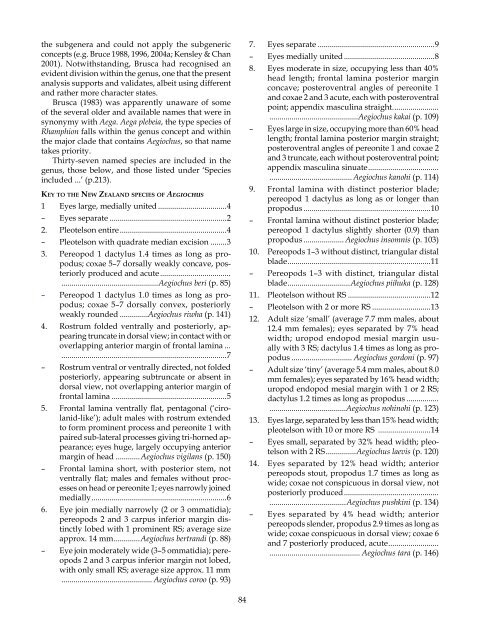The Marine Fauna of New Zealand: Isopoda, Aegidae (Crustacea)
The Marine Fauna of New Zealand: Isopoda, Aegidae (Crustacea)
The Marine Fauna of New Zealand: Isopoda, Aegidae (Crustacea)
You also want an ePaper? Increase the reach of your titles
YUMPU automatically turns print PDFs into web optimized ePapers that Google loves.
the subgenera and could not apply the subgeneric<br />
concepts (e.g. Bruce 988, 996, 2004a; Kensley & Chan<br />
200 ). Notwithstanding, Brusca had recognised an<br />
evident division within the genus, one that the present<br />
analysis supports and validates, albeit using different<br />
and rather more character states.<br />
Brusca ( 983) was apparently unaware <strong>of</strong> some<br />
<strong>of</strong> the several older and available names that were in<br />
synonymy with Aega. Aega plebeia, the type species <strong>of</strong><br />
Rhamphion falls within the genus concept and within<br />
the major clade that contains Aegiochus, so that name<br />
takes priority.<br />
Thirty-seven named species are included in the<br />
genus, those below, and those listed under ‘Species<br />
included ...’ (p.2 3).<br />
Key to the new <strong>Zealand</strong> species <strong>of</strong> Aegiochus<br />
Eyes large, medially united ..................................4<br />
– Eyes separate ..........................................................2<br />
2. Pleotelson entire .....................................................4<br />
– Pleotelson with quadrate median excision ........3<br />
3. Pereopod dactylus .4 times as long as propodus;<br />
coxae 5–7 dorsally weakly concave, posteriorly<br />
produced and acute ...................................<br />
................................................Aegiochus beri (p. 85)<br />
– Pereopod dactylus .0 times as long as propodus;<br />
coxae 5–7 dorsally convex, posteriorly<br />
weakly rounded ..............Aegiochus riwha (p. 4 )<br />
4. Rostrum folded ventrally and posteriorly, appearing<br />
truncate in dorsal view; in contact with or<br />
overlapping anterior margin <strong>of</strong> frontal lamina ...<br />
..................................................................................7<br />
– Rostrum ventral or ventrally directed, not folded<br />
posteriorly, appearing subtruncate or absent in<br />
dorsal view, not overlapping anterior margin <strong>of</strong><br />
frontal lamina .........................................................5<br />
5. Frontal lamina ventrally flat, pentagonal (‘cirolanid-like’);<br />
adult males with rostrum extended<br />
to form prominent process and pereonite with<br />
paired sub-lateral processes giving tri-horned appearance;<br />
eyes huge, largely occupying anterior<br />
margin <strong>of</strong> head ............Aegiochus vigilans (p. 50)<br />
– Frontal lamina short, with posterior stem, not<br />
ventrally flat; males and females without processes<br />
on head or pereonite ; eyes narrowly joined<br />
medially ...................................................................6<br />
6. Eye join medially narrowly (2 or 3 ommatidia);<br />
pereopods 2 and 3 carpus inferior margin distinctly<br />
lobed with prominent RS; average size<br />
approx. 4 mm .............Aegiochus bertrandi (p. 88)<br />
– Eye join moderately wide (3–5 ommatidia); pereopods<br />
2 and 3 carpus inferior margin not lobed,<br />
with only small RS; average size approx. mm<br />
............................................. Aegiochus coroo (p. 93)<br />
84<br />
7. Eyes separate ..........................................................9<br />
– Eyes medially united .............................................8<br />
8. Eyes moderate in size, occupying less than 40%<br />
head length; frontal lamina posterior margin<br />
concave; posteroventral angles <strong>of</strong> pereonite<br />
and coxae 2 and 3 acute, each with posteroventral<br />
point; appendix masculina straight. ......................<br />
............................................Aegiochus kakai (p. 09)<br />
– Eyes large in size, occupying more than 60% head<br />
length; frontal lamina posterior margin straight;<br />
posteroventral angles <strong>of</strong> pereonite and coxae 2<br />
and 3 truncate, each without posteroventral point;<br />
appendix masculina sinuate ...................................<br />
......................................... Aegiochus kanohi (p. 4)<br />
9. Frontal lamina with distinct posterior blade;<br />
pereopod dactylus as long as or longer than<br />
propodus ............................................................... 0<br />
– Frontal lamina without distinct posterior blade;<br />
pereopod dactylus slightly shorter (0.9) than<br />
propodus .................... Aegiochus insomnis (p. 03)<br />
0. Pereopods –3 without distinct, triangular distal<br />
blade .......................................................................<br />
– Pereopods –3 with distinct, triangular distal<br />
blade ...............................Aegiochus piihuka (p. 28)<br />
. Pleotelson without RS ......................................... 2<br />
– Pleotelson with 2 or more RS ............................. 3<br />
2. Adult size ‘small’ (average 7.7 mm males, about<br />
2.4 mm females); eyes separated by 7% head<br />
width; uropod endopod mesial margin usually<br />
with 3 RS; dactylus .4 times as long as propodus<br />
.............................. Aegiochus gordoni (p. 97)<br />
– Adult size ‘tiny’ (average 5.4 mm males, about 8.0<br />
mm females); eyes separated by 6% head width;<br />
uropod endopod mesial margin with or 2 RS;<br />
dactylus .2 times as long as propodus ................<br />
......................................Aegiochus nohinohi (p. 23)<br />
3. Eyes large, separated by less than 5% head width;<br />
pleotelson with 0 or more RS .......................... 4<br />
– Eyes small, separated by 32% head width; pleotelson<br />
with 2 RS ...............Aegiochus laevis (p. 20)<br />
4. Eyes separated by 2% head width; anterior<br />
pereopods stout, propodus .7 times as long as<br />
wide; coxae not conspicuous in dorsal view, not<br />
posteriorly produced ...............................................<br />
......................................Aegiochus pushkini (p. 34)<br />
– Eyes separated by 4% head width; anterior<br />
pereopods slender, propodus 2.9 times as long as<br />
wide; coxae conspicuous in dorsal view; coxae 6<br />
and 7 posteriorly produced, acute .........................<br />
............................................. Aegiochus tara (p. 46)

















